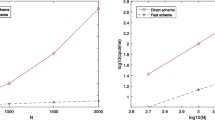Abstract
Problems for time-dependent equations in which processes are characterized by different time scales are studied. Parts of the equations describing fast and slow processes are distinguished. The basic features of such problems related to their approximation are taken into account using finer time grids for fast processes. The construction and analysis of inhomogeneous time approximations is based on the theory of additive operator–difference schemes (splitting schemes). To solve time-dependent problems with different time scales, componentwise splitting schemes and vector additive schemes are used. The capabilities of the proposed schemes are illustrated by numerical examples for the time-dependent convection–diffusion problem. If convection is dominant, the convective transfer is computed on a finer time grid.








Similar content being viewed by others
REFERENCES
G. A. Pavliotis and A. Stuart, Multiscale Methods: Averaging and Homogenization (Springer, New York, 2008).
M. O. Steinhauser, Computational Multiscale Modeling of Fluids and Solids: Theory and Applications, 2nd ed. (Springer, Berlin, 2017).
E. Weinan, Principles of Multiscale Modeling (Cambridge University Press, Cambridge, 2011).
Ch. Kuehn, Multiple Time Scale Dynamics (Springer, Cham, 2015).
H.-O. Kreiss, “Problems with different time scales,” Acta Numerica 1, 101–139 (1992).
B. Engquist and Y.-H. Tsai, “Heterogeneous multiscale methods for stiff ordinary differential equations,” Math. Comput. 74 (252), 1707–1742 (2005).
A. Abdulle, E. Weinan, B. Engquist, and E. Vanden-Eijnden, “The heterogeneous multiscale method,” Acta Numerica 21, 1–87 (2012).
J. Geiser, “Recent advances in splitting methods for multiphysics and multiscale: Theory and applications,” J. Alg. Comput. Technol. 9 (1), 65–93 (2015).
J. Geiser, Multicomponent and Multiscale Systems: Theory, Methods, and Applications in Engineering (Springer, Cham, 2016).
G. I. Marchuk, “Splitting and alternating direction methods,” in Handbook of Numerical Analysis, Ed. by P. G. Ciarlet and J.-L. Lions (North-Holland, 1990), Vol. I, pp. 197–462.
P. N. Vabishchevich, Additive Operator-Difference Schemes: Splitting Schemes (de Gruyter, Berlin, 2014).
A. A. Samarskii, The Theory of Difference Schemes (Marcel Dekker, New York, 2001).
L. Angermann and P. Knabner, Numerical Methods for Elliptic and Parabolic Partial Differential Equations (Springer, New York, 2003).
C. Grossmann, H. G. Roos, and M. Stynes, Numerical Treatment of Partial Differential Equations (Springer, Berlin, 2007).
V. Thomée, Galerkin Finite Element Methods for Parabolic Problems (Springer, Berlin, 2006).
A. A. Samarskii, P. P. Matus, and P. N. Vabishchevich, Difference Schemes with Operator Factors (Kluwer, Berlin, 2002).
V. N. Abrashin, “A version of the alternate direction method for solving multidimensional problems of mathematical physics,” Differ. Uravn. 26, 314–323 (1990).
P. N. Vabishchevich, “Vector additive difference schemes for evolutionary first-order equations,” Zh. Vychisl. Mat. Mat. Fiz. 36 (3), 44–51 (1996).
A. A. Samarskii, P. N. Vabishchevich, and P. P. Matus, “Stability of Vector Additive Schemes,” Doklady Math. 58, 133–135 (1998).
K. W. Morton and R. B. Kellogg, Numerical Solution of Convection–Diffusion Problems (Chapman & Hall, London, 1996).
A. A. Samarskii and P. N. Vabishchevich, Numerical Methods for Convection–Diffusion Problems (URSS, Moscow, 1999) [in Russian].
A. Logg, K. A. Mardal, and G. Wells, Automated Solution of Differential Equations by the Finite Element Method: The FEniCS Book (Springer, 2012).
ACKNOWLEDGMENTS
This work was supported by the Government of the Russian Federation, project no. 14.Y26.31.0013.
Author information
Authors and Affiliations
Corresponding author
Additional information
Translated by A. Klimontovich
Rights and permissions
About this article
Cite this article
Vabishchevich, P.N., Zakharov, P.E. Numerical Solution of Time-Dependent Problems with Different Time Scales. Comput. Math. and Math. Phys. 58, 1552–1561 (2018). https://doi.org/10.1134/S0965542518100123
Received:
Published:
Issue Date:
DOI: https://doi.org/10.1134/S0965542518100123




